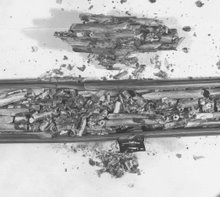Here are quotes from NRC's inspection report for River Bend, ML060600503, February 28, 2006:
General Electric (the fuel vendor) calculated that the cladding surface temperatures exceeded 1200 F in localized areas.
and
The team noted that the thermal resistance of crud is not normally sufficient to cause cladding temperature increases consistent with those observed during Cycle 8. In most circumstances, "wick boiling" occurs within the crud. That is, capillary coolant channels within the crud deliver coolant to the cladding surface. Steam then escapes from the cladding surface in chimney type plumes. This is a fairly effective method of heat transfer. However, in some instances the capillary coolant channels can become clogged, creating a static steam blanket on the cladding surface. Steam is an exceptionally good thermal insulator. This is the process that caused the very high cladding surface temperatures and ultimately resulted in fuel cladding failure.
Now, "wick boiling" is a fabrication from somewhere, and the above quote is a myth. So, I sent an e-mail to Chairman NRC advising him to get that paragraph eliminated. I e-mailed, "Indeed that entire paragraph should be deleted in a corrected report. The team should study report ANL 6136."
I should also have told the Chairman to have the inspection team study McAdams, Heat Transmission, 1942, Chapter X, HEAT TRANSFER TO BOILING LIQUIDS. On page 316, "The small amount of scale necessary to reduce a high coefficient by a substantial amount is not generally realized."
Maybe the NRC thinks that crud is not scale!
Subscribe to:
Post Comments (Atom)

No comments:
Post a Comment